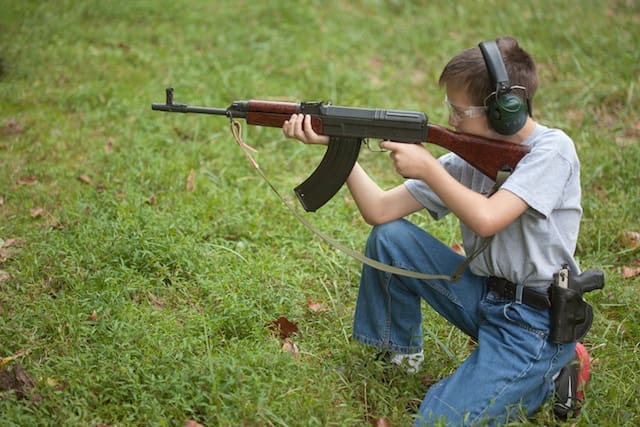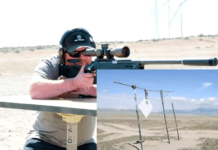Yesterday, I called the waambulance regarding my 13-year-old step-daughter’s desire for ever-increasing amounts of independence. After being upbraided by members of TTAG’s Armed Intelligentsia for police state-style parenting, I’d like to take that kids-safety-guns dialogue in a different direction. What does shooting teach children? It’s a moot point for my SD; she’s about as interested in firearms as she is in putting her plate into the dishwasher. And thanks to an upbringing so liberal my parents practically rolled my joints (i.e. anti-gun), I didn’t even know there was a ballistic boat to miss. Despite my experiential ignorance, I know that guns ‘n kids are a good mix (when supervised properly). For all those new shooters/breeders coming into the forearms fold, what are the three main lessons that shooting can teach their kids?





Responsibility, obedience, attention to detail.
Patience
Respect for machinery
Physics
Gabriel and GS650G (apparently a fan of ’80s Suzukis) both gave excellent answers. I would add only love of the outdoors and respect for life.
I absolutely agree with your sentiments Magoo.
Way more than 3!
Planning
Focus
Discipline
Respect
Math & Physics
Responsibility
Control
First: the world is a dangerous place, second: personal responsibility, and third: personal achievement.
In their first shooting lesson I taught my children about the dangers of firearms and how their careless actions could cause someone’s death. Once they learned the rules of safety they learned basic handling and marksmanship, and from those things came a sense of accomplishment at having hit what they were aiming for. These are very good lessons for a child to learn, and they were demonstrated in a practical, hands-on and satisfying way. I highly recommend it.
“how their careless actions could cause someone’s death.”
This is a very important lesson in a child’s life. Once they have grasped that concept as it pertains to firearms, it is much easier to expand the concept to include the immense responsibility and possible dire consequences when driving a car, when drinking, when “just messing around”, etc.
It is also a great way to teach about taking responsibility for one’s actions/mistakes.
I agree.
BTW, I used milk jugs filled with water to demonstrate the effect of the bullet on the target as opposed to paper targets. In addition to providing instant feedback on a hit, they burst and leak. I would then ask the children to consider how this would be similar to shooting a person. Of course, this requires the use of an outdoor range, but the extra trouble would be worth it to those who don’t have easy access to one.
You can also compare BB guns and air rifles to firearms this way to show how much more destructive firearms are.
Entry into the adult world (along with the points made above).
Once I was allowed to carry a gun into the field to hunt with my father, I was now a character in the stories that would be told about my family. No longer would I simply be a passive listener to the tales about dad, grandpa, uncle Winfield, and the rest–the gun is a tangible marker of maturity.
Responsibility, all sorts of mechanical and physical concepts, and the simple truth that sending lead downrange is fun. I’ve never met a SINGLE person raised (properly) with firearms who wasn’t a squared-away and generally useful individual.
Respect for the wise (mom, pop, RO’s, LEO’s, Mr. Browning)
Cleanliness
Social Skills (who doesn’t socialize at the range?)
Ditto to all of the above and in addition it teaches them that guns are not evil machines hell-bent on the destruction of man. It seems most people that hate guns have no experience with them and people tend to fear what they don’t understand. Start ’em off early just like swimming. Also, shooting is EXTREMELY fun.
Self-control … literally. I shot competitive rifle from the age of 13 to 18. I learned to control my breathing, heart rate, and muscle tension. Shooting 10 rounds in 10 minutes through a 12 pounds single-shot bolt action match rifle is a meditative exercise.
Now when I get stressed I fall back on the lessons I learned. I can cut through the clutter and focus. If you want a more eloquent explanation give Zen in the Art of Archery a read. It applies to almost any form of marksmanship.
Absolutely.
Integration of mind and body in the pursuit of a goal, with measurable results. A gun is essentially a loud biofeedback device. Anyone can say they’re centered, but the target tells the truth. You get a kid started on that mental exercise from a young age, and it will carry over to the rest of their life.
What the youth of America need is less Ritalin, and more single-shot .22 target rifles.
Absolutely. I have ADHD and the only time my symptoms completely disappear is on the firing line. But the lessons learned their help me throughout my day.
Self-confidence. Mastering the chaos and power of gunfire, directing a round downrange into a tiny target and knowing that a dangerous act was made safe is a confidence-builder for a lot of people. When kids are confident within themselves, they don’t sell out. Don’t confuse teenage cockiness for confidence; it’s just the opposite, a defense against self-doubt.
+11. Yes! That’s what kids are lacking these days. They don’t need us to give them esteem. They need to learn how to build it.
Outstanding.
Concentration, responsibility.
My son recently started shooting with me last year. He was 12 at the time. We spent a LOT of time at the range. When he went back to school, we noticed his ability to concentrate skyrocketed. When the teachers asked what we changed – you should see the look of horror on their faces when we mention shooting marksmanship.
It worked out really well for us.
Dad of the year.
Ideally, with the right guidance, it might help provide an additional anchor line of sorts to an American heritage along with appreciating the associated values of independence, freedom, and self-reliance.
Taming an animal breeds respect for the power of the animal. Taming a firearm breeds respect for the firearm.
Just the act of mastering such a powerful tool will have a manifest effect on a child who is otherwise in good repair. The first time I printed a target in Scout Camp with a bolt action 22 was a great day.
In my specific case teaching my kids to shoot will teach them a love for a new sport or hobby, also give them hands on with firearms safety rules, and also to learn how to respect and at the safe time have fun with firearms.
Thank goodness I re-read the title. I thought you asked what shooting children teaches! Number one is that it’s hard to hit the little buggers, what with them being smaller targets than adults and quick to boot. Anyway, carry on.
How many parents have thought once or twice, “If only it weren’t illegal…”?
Proper lead and holdover. 😉
1. That some rules are never to be broken (e.g., Never let the muzzle cover anything you aren’t willing to destroy).
2. That you are responsible for your actions, and that all actions have consequences.
3. That sometimes, despite your best efforts, things will not go as planned. The proper response to this situation is to practice and try again, not give up and pout.
IMO,
Not EVERY child is responsible enough to handle firearms, regardless of what they’re taught.
For the majority that are, there is a great deal to be learned.
Discipline, responsibility, and that guns in and of themselves are not dangerous – only the person holding them can make them dangerous.
It was something I could share with my children
It taught them to respect–but not to fear–firearms
It was fun
Talk about an echo chamber, unless I missed one, even Magoo was in agreement with every one of you guys on the positive lessons to be learned.
Truthfully, I agree with a lot of what I read, however it’s not all kicks and giggles, guys.
One of my main concerns, and reasons I don’t teach my kids about guns, is this, especially for boys. There’s an exhiliration and sense of power that is pretty-much unmatched in other activities. Insecurities and secret fears can be compensated by this exciting new activity. In younger children, even teenagers, that’s bad. They should first learn how to grow out of those psychological weaknesses and become healthy well-balanced adults before simply “filling the hole” in this way. Think of yourselves. Surely some of you can realate to that. (Don’t worry, I don’t expect any admissions).
Another concern is that in spite of all your claims to the contrary, many kids cannot respond adequately to lessons of precaution and responsibility. It’s part and parcel of being a kid to resist those very things that are so needed in shooting guns. Teenagers frequently get into drug and alcohol experimentation, they do that macho rough-housing, they do competitive daredevil stuff, they all suffer from peer-pressure. All these things don’t mix well with guns, and can actually become lethal.
And finally, at least this is all I can think of right now, there’s the lesson transmitted that guns are the answer. Although, you probably wouldn’t purposely try to communicate that guns are the answer to everything, that is exactly the message younger kids will sometimes get. Being immature and still forming intellectually, the new-found power of the gun, the idea of participating in self-defense, the feeling of finally being “good enough” for dad and big brother and uncle and the other kids, all combine to give the wrong impression that the gun is the answer, period. Think about it yourselves, again I don’t expect an answer, but isn’t it true?
I’m thinking about these things lately because I had an experience with my 7-year-old the other day, which I’ll write about. Maybe I’ll send it to Robert directly or put in on my blog.
My son is five and owns a little .22 with AR controls. I agree with all the items above but what I found is that, while still having the attention span of a gnat, when he taught my wife to shoot (his mom), he had such pride, sense of accomplishment, and seeming maturity well beyond his years. He experienced a tremendous sense of leadership simply because we gave him a little glimpse of some of the things that make us feel proud when we grow up.
Comments are closed.